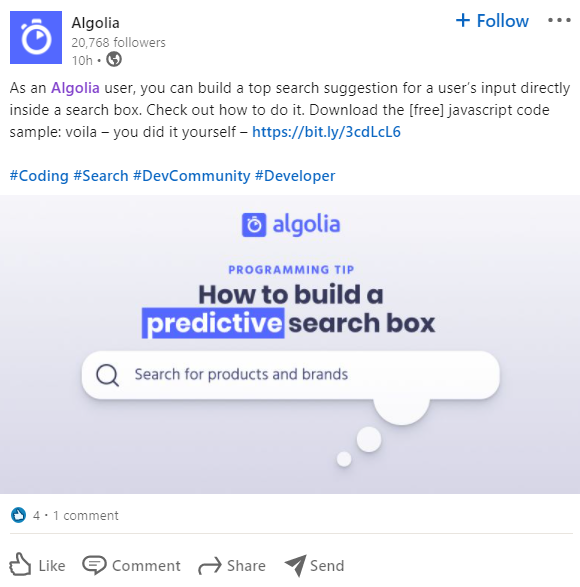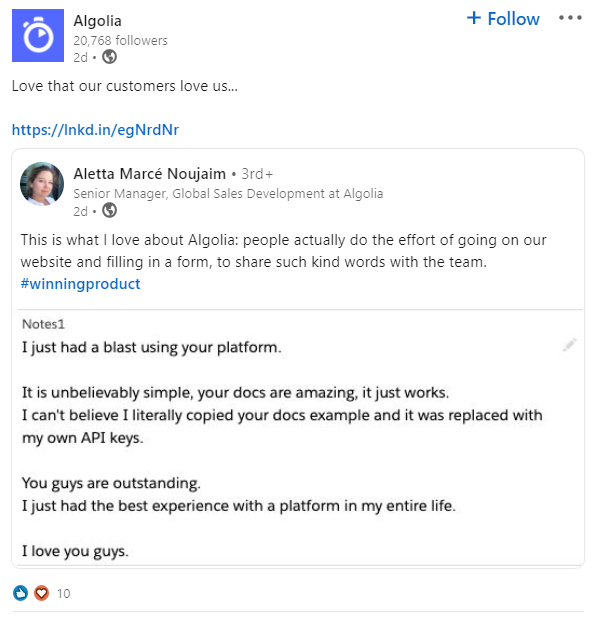As a marketer, you know getting customers’ attention can be tough, but actually closing those customers is just as much of a struggle for sales reps in your org.
That’s because the average sales process is more complex than ever. With so many opportunities for leads today to lose interest or potentially bounce to a competitor, reps need all the help they can get to make meaningful impressions on their customers.
And that’s where marketers can save the day.
By finding the link between sales enablement and marketing, you can support your business’ sales efforts and make your role as a marketer even more valuable to your business.
What is sales enablement, anyway?
Let’s kick things off with a quick definition.
Sales enablement is the act of empowering sales reps to close more deals through the help of employees outside of the sales team. In the context of marketing and sales enablement, this support comes in the form of marketing content, data and insights from customer interactions.
Again, the average B2B buyer’s journey is growing longer. Prospects and leads alike are interacting with more and more people on the path to purchase. Many of these touchpoints happen among marketers, especially as people get acquainted with your brand for the first time.
Social media posts. Landing pages. Blog posts. The list goes on.
Your marketing team is sitting on a potential goldmine of data when it comes to what customers want. The problem is that it’s easy for that ever-so-valuable data to get siloed.
Food for thought: a staggering 87% of sales and marketing leaders say that alignment between both teams is critical to business growth. Supporting your reps with data and sales enablement content not only makes your reps’ lives easier but also boosts your company’s bottom line.
Making the link between sales enablement and marketing
The good news is that you’re probably already taking action to boost your business’ sales initiatives.
Here are some examples of how sales enablement and marketing can collaborate so you can better translate support into action.
Creating sales enablement content that educates your leads
This is perhaps the most straightforward way marketing and sales can work together.
Educational content is crucial for both gathering leads and nurturing them. Some examples of sales enablement content that’s prime for social media include:
- Blog posts
- How-to videos
- Case studies
- Customer reviews and testimonials
- E-books, webinars and other lead magnets
Top-of-the-funnel content published to social media allows you to introduce customers to your business and put them on the path toward becoming qualified leads.
For example, free downloadables are perfect for funneling social traffic to your business’ landing pages and encouraging opt-ins to eventually be handed off to sales…

…meanwhile, testimonials from customers serve to nurture existing followers that might be on the fence.

These pieces of content not only fill out your social media calendar but also give sales reps helpful resources to hand over to leads. For example, a rep might advise a lead to check out a blog post about a particular product feature or case study about a similar customer.
In short, creating sales enablement content is a win-win for both teams. Over time, you can hash out which type of content performs best for attracting and closing leads from social and strive to publish more of it.
Identifying qualified leads and getting them to your sales team
No surprises here!
Leads can be gathered and qualified directly through interactions that they have on the marketing side. This might include:
- Downloading an e-book
- Attending a webinar
- Asking questions about products or reaching out via social media
- Repeatedly visiting your website or interacting with your social ads
Keep in mind that taking one of the actions above does not necessarily make someone sales-ready. In fact, it’s a common misconception that a specific click or download means that a lead is ready to buy.
For example, someone that DMs you on Twitter to ask about pricing to speak to someone from sales is more qualified than, say, someone that downloaded an e-book on a whim.
Defining what makes a lead “qualified” varies from business to business. This speaks to the importance of communication for successful sales enablement, ensuring that both teams are on the same page.
Understanding customer sentiment
Although sales reps might have a more direct relationship with leads, marketers today are in a unique position to learn what customers are thinking.
For example, social media is one of the best places to conduct market research to support your sales team. That’s because social media is totally transparent as customers sound off on brands and what they like (or dislike) about any given product.
In fact, in our recent survey of 250 business executives, 60% identified investing more resources into social media as a key way to gain a competitive advantage.

Through sentiment analysis, you can get into your audience’s headspace to understand what they’re feeling and how reps should approach them. Below is an example of sentiment analysis conducted in Sprout:

Identifying the most effective marketing channels
Leads can come from seemingly anywhere and everywhere these days.
From social media and emails to SEO and beyond, you should have a pulse on which channels perform the most in regard to sales.
For example, which types of leads convert the best? Where are most of your leads coming from? How long does it take for a social lead to close versus someone from search?
If you’re tracking your customers in a CRM such as HubSpot or Salesforce (see below), you can more easily track where folks are coming from and how they behave once they engage with your business.

These attribution insights empower you to spend your time and resources on channels that make sense, boosting your marketing and sales enablement efforts alike.
Digging into pain points and sales objections
Through social media, marketers can see directly why customers decide to make a purchase or choose a particular brand.
This applies on both a big-picture and individual level. If people are complaining about certain aspects of your or a competitors’ product, you should absolutely take note of those issues.
Lately I’ve been using @otter_ai a lot for listening to podcasts.
The rolling transcriptions are great, but more importantly, the ability to highlight text and add notes is a game changer for me. @AirrAudio does notes, but the UX has friction.
I wish @OvercastFM had this.
— Amit Jotwani ? (@amit) March 25, 2021
By understanding your customers’ pain points and objections, you can improve your content to address those objections and give your reps a jump on why certain leads might be hesitant to buy.
How to achieve sales and marketing alignment effectively
Getting your sales and marketing teams to work together doesn’t happen by accident.
To wrap things up, let’s look at some ways to encourage collaboration that benefit both parties.
Come up with a sales enablement framework
In short, you need to spell out expectations for the relationship between sales and marketing and what both teams should achieve as a result. Collaboration shouldn’t be treated as a free-for-all.
Here’s are the basics of what to address in a sales enablement framework:
- Goals. What do both teams want to get out of working together? Decide on your KPIs and desired outcomes.
- Roles. Who’s involved in the collaboration effort? For example, it might make more sense for individual managers to go back-and-forth and report back to their teams rather than involve an entire department.
- Communication. How often will you communicate and where does that communication happen? Weekly or monthly?
Your time is valuable and so is that of your sales team. Ironing out the details above will ensure that your team works towards its goals and doesn’t waste anyone’s time in the process.
Decide on your shared spaces
28% of sales experts see tech integrations with marketing as the biggest up-and-coming trend (second only to automation).
There’s no shortage of software out there that allows marketing and sales teams to collaborate. Shared spaces create a sense of visibility and accountability for your efforts, meanwhile streamlining the process of communicating.
If your teams are already plugged into a CRM, start there. Most CRM tools make it a cinch to hand off leads and keep collaborators on crucial customer touchpoints. Similarly, Sprout’s team workflows allow teams to track social interactions and make notes when it comes to customer relationships via social.

Project management platforms like Asana, Jira and Trello are also popular collaborative spaces for teams that don’t require as much immediate communication. For example, you could set up a company-wide board to track milestones, share content and discuss sales and marketing initiatives. 
There are also dedicated sales enablement tools out there such as Showpad. Their tool provides a platform to share resources and materials with sales teams in their pursuit of closing deals. For example, you can quickly share pieces of content or pitch decks with reps so they’re always plugged in on your team’s latest activities.

Heck, some teams might rely on all of the tools above. Either way, team collaboration is critical to effective sales enablement and shared spaces can help keep teams informed and productive.
Report and discuss outcomes of your initiatives
Once you’ve decided what you want to achieve and where you’ll collaborate, you’ll need to report on your actual results and outcomes.
From lead sources and sales figures and beyond, hard data is going to decide if your efforts are paying off. Literally.
The shared spaces above all allow for easy sharing of reports and data. Additionally, social media reporting via Sprout gives teams vital business intelligence from social media, like top performing content, networks and customer sentiment.

Anything you can do to avoid data silos is a plus. Seamless reporting that’s easy to share means that teams can understand what’s going on at a glance and take action. The same should apply to data from your sales team, too.
Does your business have its sales and marketing efforts aligned?
Simply put, sales enablement ultimately makes your reps and marketers more effective at doing their jobs. Bringing both teams together should be a matter of “when,” not “if.”
The framework and tools highlighted above do exactly that ASAP.
And as you’re brainstorming your sales enablement strategy, make sure to read our report with new data on how and why social makes an impact across your org, including on sales.
The post Sales enablement and marketing: How to support your reps with data appeared first on Sprout Social.